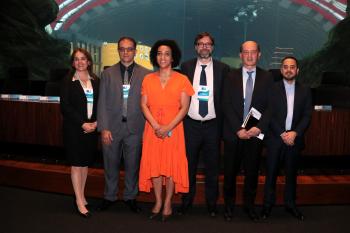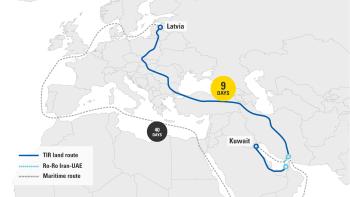From China to Brazil, 2023 saw the TIR system continue to expand, evolve and attract newcomers. This year-in-review article spotlights ten key TIR developments from 2023.
Approaching its 75th anniversary, TIR, the only global transit system, continues to be the easiest, most secure and most reliable way to move goods across borders.
TIR, which offers a guarantee of up to EUR 100,000 per operation, gets goods efficiently and securely from a country of origin, through as many transit countries as necessary, to a country of destination in sealed load compartments, with customs inspections taking place only at the place of origin and destination.
Here are ten TIR developments from 2023 showcasing the impact of the system.
1. Iraq joins TIR
The Republic of Iraq became the 78th country to accede to the TIR Convention in March 2023.
Recognising the significance of a new country joining TIR, Umberto de Pretto, IRU’s Secretary General, had then commented, “Iraq’s accession to TIR is a golden opportunity to confirm the country’s readiness to leverage the potential of international trade in supporting economic growth and driving prosperity and development.”
The implementation of TIR in Iraq, a country surrounded by TIR operational neighbours, with Iran and Türkiye being two of the biggest TIR issuing countries, will harmonise trade and transit, boosting transparency and efficiency.
2. Strong China momentum
After withstanding the challenges imposed by Covid-19, TIR operations from China resumed in early 2023.
Over 15 new routes were launched this year, notably linking China with Afghanistan, Mongolia, Central Asia, and Pakistan, further diversifying regional transport routes to facilitate growing trade.
Successful caravans on key regional corridors, such as China-Kyrgyzstan-Uzbekistan, China-Pakistan Economic Corridor (CPEC) and Asian Highway Route 4, have injected new impetus to drive greater regional connectivity and prosperity.
Eleven new customs checkpoints have opened for TIR operations, most located in inland logistics hubs, where companies can enjoy unique benefits, streamlined border procedures, and secure door-to-door delivery.
In 2023, for the first time, a complete TIR movement was conducted by a Chinese company. With Chinese companies’ growing interest and confidence in international road transport business and TIR, the total number of Chinese TIR hauliers doubled this year.
TIR now connects China with more than 30 countries across Eurasia, offering more secure transport options that are over 80% faster and 50% cheaper.
3. GCC growth
TIR has been expanding rapidly in the Gulf Cooperation Council (GCC) region, from Oman and the United Arab Emirates (UAE) to Saudi Arabia, and most recently Qatar, significantly reducing border-crossing times and boosting regional trade.
In the second half of 2023, the GCC experienced an exponential growth in demand for TIR compared to 2022.
GCC governments are now increasingly expediting TIR’s implementation. Having witnessed the facilitation and security benefits brought by the system, GCC governments such as Saudi Arabia have now introduced dedicated express lanes for TIR trucks, a business-to-government TIR IT integration system, faster handling, and dedicated parking areas.
4. Brazil on TIR path
In October, IRU, Brazil’s Ministry of Foreign Affairs and IRU member NTC&Logística held a two-day conference in Campo Grande on how TIR would bolster trade in South America, including along the Bioceanic Corridor.
The Bioceanic Corridor is a highway that will span the full width of South America, from Brazil to Chile, opening new export opportunities from the Pacific, especially to China.
The conference was attended by senators, transport authorities and operators from across the country, Paraguayan senators and representatives from the Ministry of Transport, as well as public and private sector participants from Argentina.

IRU is working with its members and public authorities to support Brazil’s accession to TIR, as well as TIR’s implementation in Argentina, Chile and Uruguay.
5. TIR Green Lanes
Building on TIR’s efficiency benefits, countries are increasingly adding TIR Green Lanes at their borders.
TIR Green Lanes (express lanes at border crossings for TIR traffic) cut border crossing times, optimise transit flows with risk management mechanisms, and increase transit security.
In May, Turkmenistan established Green Lanes at ten border crossings with Afghanistan, Iran, Kazakhstan and Uzbekistan to prioritise customs clearance for TIR transport, as communicated in an IRU Flash Info.
In Kyrgyzstan, operators and shippers who send advance cargo information to Kyrgyz customs via TIR-EPD can now benefit from dedicated processing booths at the Dostuk border, the implementation of which was supported by the Organization of Turkic States.
6. From 40 days to just 9
Rather than taking 40 days by sea, the Milton Group transported goods from Europe to the Middle East with TIR – crossing 13 countries – in just nine days.
The goods departed from Latvia and transited Lithuania, Poland, the Czech Republic, Slovakia, Hungary, Romania, Bulgaria, Türkiye, Iran via the Bandar Abbas port and then to the United Arab Emirates using a Ro-Ro vessel and finally the Kingdom of Saudi Arabia, before arriving at its destination in Kuwait.

Two drivers alternated to drive through the 13 countries according to regional driving and rest time rules.
As the only global transit system, the TIR system allowed the truck to seamlessly and intermodally pass countries and customs along the way.
7. Digitalisation
Central Asia is at the heart of east-west connectivity. With trade facilitation tools such as TIR, landlocked Central Asian countries have turned themselves into land-linked regional trade hubs.
They are also leading the way in TIR digitalisation. Central Asia’s private sector and customs administrations, with the support of the German Agency for International Cooperation (GIZ), have fully digitalised business to customs data exchanges, raising TIR’s security to a new level with advance risk management of TIR operations.
All five Central Asian countries are now on their way to full TIR digitalisation with eTIR.
8. New TIR associations group
The first meeting of the newly created “Economic Cooperation Organization-TIR National Associations Consultative Group (ECO-TIRACG)” was held in October to review its key responsibilities as well as regional border optimisation opportunities.
ECO-TIRACG was created to relay the private sector’s inputs to ECO bodies on transport and transit facilitation and further leverage the TIR system, which is experiencing an upward trend in ECO countries such as Azerbaijan, Iran, Kyrgyzstan, Pakistan, Türkiye, Turkmenistan, and Uzbekistan.
The ECO-TIRACG meeting also weighed other border crossing best practices, including TIR Green Lanes, intelligent queueing and e-queueing mechanisms, and simplified visa and permit procedures.
9. Huawei opts for TIR
In early 2023, Huawei joined the likes of FedEx Express and DB Schenker by turning to TIR to better serve customers in Saudi Arabia and the rest of the GCC region.
Huawei is now enjoying remarkable time savings when delivering their products under TIR. TIR has been used for 1,800 Huawei deliveries so far.
The TIR system is operational across the GCC, reducing transport times between Jordan and the UAE via Saudi Arabia by 50%, over 70% between Oman and Saudi Arabia, and over 90% between the UAE and Saudi Arabia.
10. Aid delivery
Following the devastating earthquake that hit Eastern Türkiye and northern Syria in February 2023, the TIR system was used to efficiently transport humanitarian supplies across borders.
Pakistani operator NLC transported humanitarian aid – including tents, blankets and other basic aid supplies – to Türkiye via Iran, using TIR and the Islamabad-Tehran-Istanbul (ITI) corridor.
The ITI corridor was activated jointly by ECO, IRU, Pakistan, Iran and Türkiye in October 2021. On average, the TIR-backed corridor has slashed 80% off transit times compared to the habitual maritime route.
Many new TIR corridors have been opened in the region jointly with the NLC, including Pakistan-Afghanistan-Uzbekistan-Kazakhstan, China-Pakistan-Afghanistan, and China-Kyrgyzstan-Kazakhstan-Pakistan.
